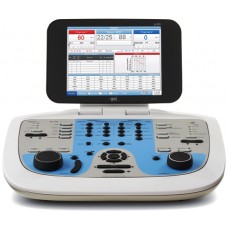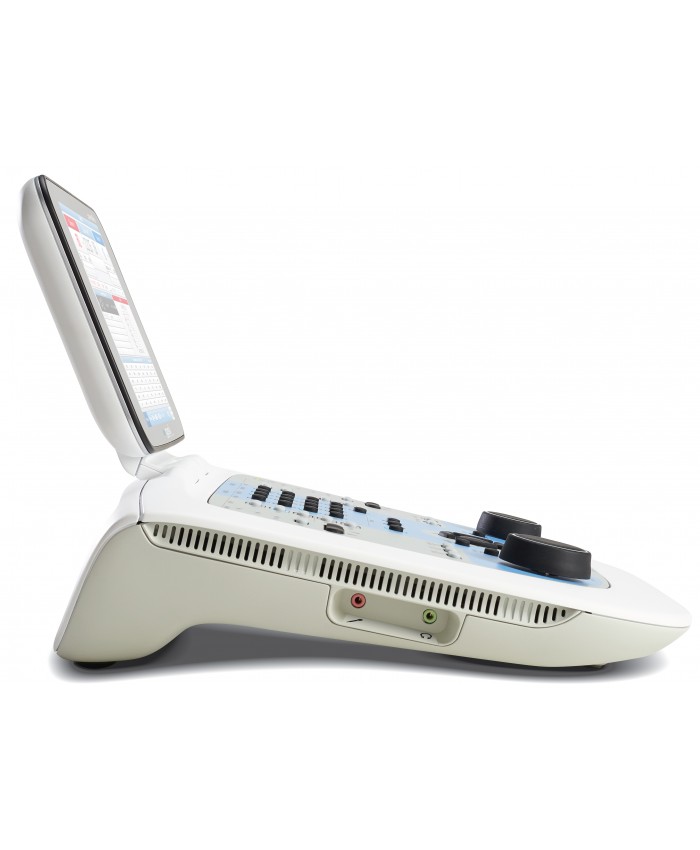GSI Pello
The new GSI Pello™ is an adaptable audiometer with a small footprint and familiar Grason-Stadler design. This mid-level audiometer is the perfect solution for a growing practice because of its flexibility. Four configuration options allow each facility to mix and match features based on clinic and patient needs
1. Choose from 3 license options to meet your needs; Speech Plus, High Frequency and Special Tests that may be added on to the standard configuration.
2. User-configurable tests on preferences provide efficient workflow and optimize the speed of testing.
3. Use independently or with a computer. With one button press, transfer data to GSI Suite for management of records, apply counseling overlays and quick transfer to Noah for hearing aid fittings.
4. Small and lightweight design makes the Pello audiometer ideal for multiple environments.
5. Recognized worldwide as the preferred and most user-friendly front panel design.
6. Quickly access pure tone and speech audiometry; one button press facilitates the transition of stimuli and test protocols.
Channels - 1.5
Pure Tone
FREQUENCY RANGE
Air Conduction: 125 Hz to 12,000*** Hz
High Frequency*: 8,000 Hz to 20,000 Hz (8 kHz, 9 kHz, 10 kHz, 11.2 kHz, 12.5 kHz, 14 kHz, 16 kHz, 18 kHz*** and 20 kHz***)
Full Frequency Range*: 125 Hz to 20,000 Hz
Bone Conduction: 250 Hz to 8,000 Hz
Sound Field*: 125 Hz to 8,000 Hz
Paired Inserts*: 125 Hz to 8,000 Hz
Frequency Accuracy: ± 1 %
Total Harmonic Distortion: < 2% (earphones and paired insert phones*) < 5% (bone vibrator)
INTENSITY RANGE**
Air Conduction: -10 dB HL to 120 dB HL
High Frequency*: -10 dB HL to 120 dB HL
Bone Conduction (B81):
-10 dB HL to 85 dB HL (mastoid)
-10 dB HL to 75 dB HL (forehead)
Sound Field*: (external amplifier required):
-10 dB HL to 90 dB HL (basic speakers)
-10 dB HL to 102 dB HL (high performance speakers)
Paired Inserts*: -10 dB HL to 120 dB HL
Masking Intensity Range (Calibrated in effective masking) Narrow Band Noise: Maximum dB HL is 15 dB below tone
SIGNAL FORMAT
Steady: Tone continuously present
Pulsed: Tone pulsed 200 msec ON, 200 msec OFF
FM: Modulation Rate: 5 Hz
Modulation depth +/- 5%
Pediatric Noise*: Continuously presented or pulsed
Speech
Microphone: For live voice testing and communications
INT/EXT A & INT/EXT B: Can be utilized for internal wave files or recorded speech material from an external digital device
INTENSITY RANGE
Air Conduction: -10 dB HL to 100 dB HL
Bone Conduction:
-10 dB HL to 60 dB HL (mastoid)
-10 dB HL to 50 dB HL (forehead)
Sound Field*: -10 dB HL to 90 dB HL (basic speakers)
Paired Inserts*: -10 dB HL to 95 dB HL
SPEECH NOISE
Air Conduction: -10 dB HL to 100 dB HL
Bone Conduction:
-10 dB HL to 50 dB HL (mastoid)
-10 dB HL to 40 dB HL (forehead)
Sound Field: -10 dB HL to 80 dB HL
WHITE NOISE
Air Conduction: -10 dB HL to 95 dB HL
Bone Conduction:
-10 dB HL to 60 dB HL (mastoid)
-10 dB HL to 50 dB HL (forehead)
Sound Field: -10 dB HL to 80 dB HL
Special Tests*
ALT (ABLB): Tone alternating between Channel 1 and Channel 2: Channel 1 is 400 msec ON, 400 msec OFF followed by Channel 2, 400 msec ON, 400 msec OFF.
SISI: An intensity increment is added to a tone in the selected channel for 200 msec, every 5 seconds. The HL increments are in 1, 2 or 5 dB.
High Frequency: Pure tone testing in the frequency range of 8,000 Hz to 20,000 Hz using circum-aural headphones.
TEN: TEN masking noise will be presented to the test ear. Pure tone stimuli between 500 and 4000 Hz may be used at 1, 2, or 5 dB increments to obtain TEN thresholds.
QuickSIN: Six (6) sentences with five (5) key words per sentence are presented in four-talker babble noise. The sentences are presented at prerecorded signal-to-noise ratios. The SNR’s used are 25, 20, 15, 10, 5 and 0.
BKB-SIN: 18 List Pairs. The sentences are presented at prerecorded signal-tonoise ratios that decrease in 3-dB steps. Each list in the pair is individually scored, and the results of the two lists are averages to obtain the List Pair score. Results are compared to normative data to obtain the SNR Loss.
Tone Decay: Presents a continuous pure tone with timer.








